STREAM-LINED
The practical, hobby Mealworm Farm is ever stream-lining. My system of only 9 drawers required creativity to get the most out of the limited space available; that being two, plastic canvas bottomed drawers, namely, the Beetle Drawer and the Self Sift/Sort Drawer.
BEETLE DRAWER
The Beetle Drawer contains the breeding beetles, of course. Underneath their canvas-bottomed drawer is the solid-bottomed, Nursery Drawer, which is left in place for a period of 4 weeks and marked in numerical order or by date. The large space of time the Nursery Drawer is left under the beetles make a noticeable size difference as the larvae mature at different rates throughout the drawer.
SELF SORT/SIFT DRAWER
As the mature larvae in the oldest dated drawer begin to pupate rapidly, I pour the entire contents of that drawer into the Self Sort/Sift Drawer. Smaller worms, substrate and frass fall through this drawer into a Grow Out Container (or extra drawer if available), while the larger worms left on the canvas are readied for use or to sell.
GROW OUT CONTAINER OR DRAWER
Approximately four to six weeks later, to coincide with the next mature drawer ready to process, the Grow Out Container/ Drawer is again poured into the Self Sort/Sift Drawer. Again, smaller worms fall through, larger worms are used or sold.
SIMPLE EFFORT
Shifting and sorting of drawers may sound complicated, but, for the most part it is just a matter of timing and requires minimal organizational skills. To see the productivity of such a simple effort is rewarding, enjoyable, and profitable enough for my need. [For more information, see the page, Mealworm Farm, on my blog!]
 |
| Plastic canvas was a sensible choice for two drawers in my system! |
UPDATE: I went to a solid bottom system of mealworm farming, which is, moving the beetles to new substrate on a regular basis. I continued to use the mesh drawer for sifting frass or sorting large/large-medium mealworms from smalls, until it was discontinued after much use in that way.



















